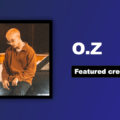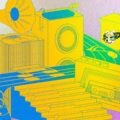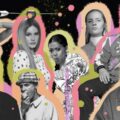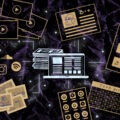Nychölas Bougie and Timothée Lucio enrolled at RAC in 2017 with the goal of becoming artistically independent. Their paths first crossed in class, but it was only later on that they came up with the idea behind Les Entreprises HoneyPhonic. Sharing a strong environmental conscience and limitless approach to sound, the two became king bees together.
For Nychölas, who calls himself a bee charmer, the name HoneyPhonic makes perfect sense in the world of audio since bees are constantly buzzing with sound. For both founders, the insects are crucial to agriculture and the ecosystem as a whole – just like sound is part of our daily lives.
That’s why, as soon as you check out their website & social media, you notice their initiative to help save the bees worldwide, along with offering a wide range of audio services, from meditation music to foley and audiobooks.
RAC: Can you tell us more about being involved in saving the bees? Are you associated with any organizations?
Nychölas: We already had a dedicated career as artists. Me as a singer-songwriter, and Tim as a hip hop artist in France. In a way, it was important for us to have a business mission. The protection of bees is very important and it’s not talked about much either. We’ve approached a few organizations but our philosophy is not to choose one specifically: it’s more about the client’s location.
We’ve had projects with people from Atlanta, China, and even South Africa. We leave it up to the client to decide which beekeeping organization they want to work with. That’s why we make a difference internationally. Our impact isn’t just in Quebec or France: it’s worldwide.
Tim: We also figured we’d open ourselves up to any type of environmental organization with an important cause. It means a lot to us if we can do something on our part. I looked around in my hometown, Nice, and the problem with these associations is that they have good projects but they lack the money to go further in their actions. We thought it would be nice to give 5% of the money we earn from each contract to these associations so that they can concretely carry out actions that will have even more impact.
RAC: What led you to offer meditation music production services? Is there a market demand for it?
Nychölas: I was a certified massage therapist for 16 years. Already after 5 years in the field, I was tired of listening to the little waterfalls and bird songs. I started looking for music that was a bit more modern. My colleagues were saying the same thing. So why not go for it and make a place for yourself in the market?
Tim: And we actually realized that’s what’s so great about music: it’s not just about being a sound engineer, working on big movies and releasing albums. Sound can also cure many things. For example with audiobooks: it’s good for kids who have trouble reading or otherwise. When you’re staring at your screen all day, it’s good to listen to a podcast or an audiobook. I think sound can be really healing.
Honestly, there’s no limit to sound. It’s true that when we’re in school, we think we have to limit ourselves to music or film production. But it can actually go much further than that.
RAC: On top of meditation music, you offer a wide range of audio services: sound design and foley, audiobooks, commercials, composition, etc. Why did you choose to broaden your horizons instead of specializing as many do?
Nychölas: The original idea was just to sell sound packs for video games. Ultimately, everything we do connects in some way, whether it’s foley, sound design, or music composition. We are versatile and enjoy it, so why not?
Tim: The other services came over time since we had developed several other skills from our personal experiences and from studying at RAC. We figured we could actually expand and offer a whole range of services and see what worked from there. I think you shouldn’t just stick to what you know or what you think you should do. It’s great to be able to jump around and try to grow as much as possible in the audio industry, which is a bit unique.
Even today, there are many untapped markets in Quebec compared to other places – like the audiobook market, for example. So we’re active on that scene, looking forward to the future.
RAC: You started the company by offering different user interface (UI) sound packs and sound effects (SFX). Where did this idea come from and what are some practical uses for someone buying them?
Nychölas: At RAC, there was an instructor who told us that there was a good market for it, so we took his advice. I started my research by attending Game Jams (online challenges for video game creation). I noticed that a lot of people were looking for UI sounds, so we started with that. It was quite a process to figure out which platform to sell them on. All of them have their terms of use and policies.
Our clients can be programmers who know how to work with sound. But we also offer a full integration service for those who need it. We are Wwise certified for audio integration in video games. It’s important to know that if you want to go into video games, you’re going to have to do the Wwise training because most clients are going to ask for it.
RAC: Among other things, you created SFX and foley for the video game Mr. Pocket’s Gold Rush and conceptualized the soundtrack and music for an American sitcom pilot in Atlanta. What kind of project(s) do you prefer?
Nychölas: Foley and sound design: I think the two kind of go hand in hand too. The pilot project in Atlanta was our most rewarding experience. It was a half-hour show and we had to create an immersive sound for all 11 scenes that could be in different locations. We also worked on a video game where we had to create soundscapes for Ancient China: two villages and a battlefield. There were sounds of swords, horses, and much more. I think it was one of the most motivating projects for me.
Tim: That’s the creative side of foley: we start from nothing and make something out of it. For example, in our village atmosphere, you can hear someone beating iron – it’s me with a vase and a ruler. The great thing about foley is that you don’t see us behind the microphone – we go from nothing, a little click, and create a soundscape. In the end, foley is part of everything, even the music composition.
RAC: What tools, equipment, or ideas do you conceptualize and create your sounds from?
Tim: It’s so broad, it can be from a synth or a microphone. We use a Zoom H5 for foley, it’s a portable 4-track recorder. We can conceptualize sounds from portable recorders like this one, from mics or in classic studios, whether it’s for vocals or specifically for foley. We don’t actually need a lot of equipment, it’s more a matter of being resourceful and figuring things out.
Nychölas: On my end, I have a lot of VSTs (virtual musical instruments) so I often make sounds with that. But our ideas start from the contracts we get, and from scripts and images if they’re provided. For example, for the podcast, we received the script with all the details about each sound and its placement. So from there, it’s just having fun and getting creative with making sounds of footsteps, clothes, office chairs, and so on.
For an UI, I once used a dog bowl. It was filled with water and I would bang on it to make the water swirl – it makes a distinctive sound. In my already soundproof basement, I made a small recording studio with mattresses. That’s the foundation of a good recording.
RAC: What lesson from RAC has been most useful in running your business?
Nychölas: Foley always interested me, but when I came to RAC, I rediscovered that passion. That’s what gave me the idea for HoneyPhonic. I learned a lot in the acoustics classes and the various workshops and master classes as well. I know HoneyPhonic wouldn’t be the same if I hadn’t studied at RAC.
Tim: It’s really the technical side. I’ve noticed a difference with the education here compared to France. At RAC, one day we do theory and the next day we practice. It allows you to go beyond just theoretical understanding, and really evaluate if you’ve got a real-world understanding of what you’ve learned. It’s not an easy year but it provides so much. Even three or four years after graduating, I still look back at my RAC class notes to remember things.
RAC: Do you have any advice for someone who wants to start a career in the audio industry?
Nychölas: At first, I didn’t know where I was going with all this, but practicing gave me a lot of confidence. Also, sometimes I didn’t know how to handle a project. I would hesitate, but once I sat down at the computer, everything would start rolling. Something happens – I think you just have to try to do things.
Tim : You have to be persistent in your projects. With time and lots of practice, they build up. There’s no limit to this kind of thing I think. Also, we are creative people and we tend to stay in our bubble sometimes. We shouldn’t be afraid to connect and create that bridge between the creator, the person who has the idea, and the person who receives it.
Entrepreneurship is liberating for both artists. They feel they have accomplished a lot in the last few years. More specifically, as many artists experience: it’s not easy to get in the door to sell your art. As Tim says: “Somewhere along the line, you have to learn to “un-demonize” the commercial side. That’s what allows you to really bring your vision to life.” We have to remember that it’s what keeps us going and, ultimately, what keeps the art going.
Written by Caroline Boivin
Translated by Maryse Bernard
Illustration by Yihong Guo






















